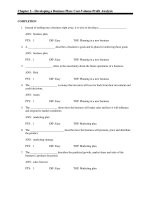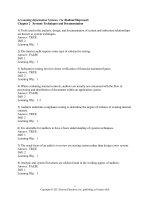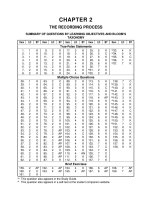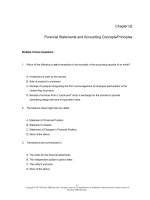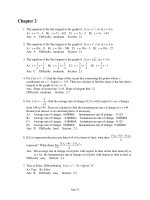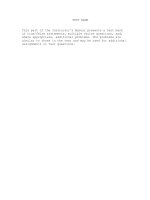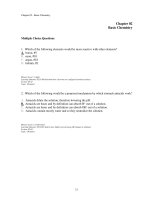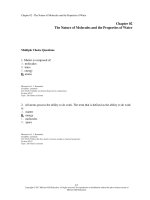Accounting what the numbers mean 11th edition marshall test bank
Bạn đang xem bản rút gọn của tài liệu. Xem và tải ngay bản đầy đủ của tài liệu tại đây (422.86 KB, 65 trang )
Chapter 02
Financial Statements and Accounting Concepts/Principles
Multiple Choice Questions
1. Which of the following is not a transaction to be recorded in the accounting records of an entity?
A. Investment of cash by the owners.
B. Sale of product to customers.
C. Receipt of a plaque recognizing the firm's encouragement of employee participation in the
United Way fund drive.
D. Receipt of services from a "quick-print" shop in exchange for the promise to provide
advertising design services of equivalent value.
2. The balance sheet might also be called:
A. Statement of Financial Position.
B. Statement of Assets.
C. Statement of Changes in Financial Position.
D. None of the above.
3. Transactions are summarized in:
A. The notes for the financial statements.
B. The independent auditor's opinion letter.
C. The entity's accounts.
D. None of the above.
2-1
Copyright © 2017 McGraw-Hill Education. All rights reserved. No reproduction or distribution without the prior written consent of
McGraw-Hill Education.
4. A fiscal year:
A. is always the same as the calendar year.
B. is frequently selected based on the firm's operating cycle.
C. must always end on the same date each year.
D. must end on the last day of a month.
5. Which of the following is not a principal form of business organization?
A. Partnership.
B. Sole proprietorship.
C. Limited unregistered business.
D. Corporation.
E. None of the above.
6. The time frame associated with a balance sheet is:
A. a point in time in the past.
B. a one-year past period of time.
C. a single date in the future.
D. a function of the information included in it.
7. Current U.S. Generally Accepted Accounting Principles and auditing standards require the
financial statements of an entity for the reporting period to include:
A. Earnings and gross receipts of cash for the period.
B. Projected earnings for the subsequent period.
C. Financial position at the end of the period.
D. Current fair values of all assets at the end of the period.
2-2
Copyright © 2017 McGraw-Hill Education. All rights reserved. No reproduction or distribution without the prior written consent of
McGraw-Hill Education.
8. The balance sheet equation can be represented by:
A. Assets = Liabilities + Stockholders' Equity
B. Assets - Liabilities = Stockholders' Equity
C. Net Assets = Stockholders' Equity
D. All of the above.
9. Stockholders' equity refers to which of the following?
A. A listing of the organization's assets and liabilities.
B. The ownership right of the stockholder(s) of the entity.
C. Probable future sacrifices of economic benefits.
D. All of the above.
E. None of the above.
10. Accumulated depreciation on a balance sheet:
A. is part of stockholders' equity.
B. represents the portion of the cost of an asset that is assumed to have been "used up" in the
process of operating the business.
C. represents cash that will be used to replace worn out equipment.
D. recognizes the economic loss in value of an asset because of its age or use.
11. The distinction between a current asset and other assets:
A. is based on how long the asset has been owned.
B. is based on amounts that will be paid to other entities within a year.
C. is based on the ability to determine the current fair value of the asset.
D. is based on when the asset is expected to be converted to cash, or used to benefit the entity.
2-3
Copyright © 2017 McGraw-Hill Education. All rights reserved. No reproduction or distribution without the prior written consent of
McGraw-Hill Education.
12. The income statement shows amounts for:
A. revenues, expenses, losses, and liabilities.
B. revenues, expenses, gains, and fair value per share.
C. revenues, assets, gains, and losses.
D. revenues, gains, expenses and losses.
13. The time frame associated with an income statement is:
A. a point in time in the past.
B. a past period of time.
C. a future period of time.
D. a function of the information included in it.
14. Revenues are:
A. cash receipts.
B. increases in net assets from selling a product.
C. increases in net assets from occasional sales of equipment.
D. increases in net assets from selling common stock.
15. Expenses are:
A. cash disbursements.
B. decreases in net assets from uninsured accidents.
C. decreases in net assets from dividends to stockholders.
D. decreases in net assets resulting from usual operating activities.
2-4
Copyright © 2017 McGraw-Hill Education. All rights reserved. No reproduction or distribution without the prior written consent of
McGraw-Hill Education.
16. The purpose of the income statement is to show the:
A. change in the fair value of the assets from the prior income statement.
B. market value per share of stock at the date of the statement.
C. revenues collected during the period covered by the statement.
D. net income or net loss for the period covered by the statement.
17. The Statement of Changes in Stockholders' Equity shows:
A. the change in cash during a year.
B. revenues, expenses, and liabilities for the period.
C. net income and dividends for the period.
D. paid-in capital and long-term debt at the end of the period.
18. Paid-in Capital represents:
A. earnings retained for use in the business.
B. the amount invested in the entity by the stockholders.
C. fair value of the entity's common stock.
D. net assets of the entity at the date of the statement.
19. Retained Earnings represents:
A. the amount invested in the entity by the stockholders.
B. cash that is available for dividends.
C. cumulative net income that has not been distributed to stockholders as dividends.
D. par value of common stock outstanding.
2-5
Copyright © 2017 McGraw-Hill Education. All rights reserved. No reproduction or distribution without the prior written consent of
McGraw-Hill Education.
20. Additional paid-in-capital represents:
A. The difference between the total amounts invested by the stockholders and the par or stated
value of the stock.
B. Distributions of earnings that have been made to the stockholders.
C. Distributions of earnings that have not been made to the stockholders.
D. The summation of the total amount invested by the stockholders and the par or stated value of
the stock.
21. The Statement of Cash Flows:
A. shows how cash changed during the period.
B. is an optional financial statement.
C. shows the change in the fair value of the entity's common stock during the period.
D. shows the dividends that will be paid in the future.
22. On January 31, an entity's balance sheet showed total assets of $2,250 and liabilities of $750.
Stockholders' equity at January 31 was:
A. $1,500
B. $3,000
C. $1,250
D. $750
23. On January 31, an entity's balance sheet showed net assets of $3,075 and liabilities of $675.
Stockholders' equity on January 31 was:
A. $2,400
B. $3,075
C. $3,750
D. $675
2-6
Copyright © 2017 McGraw-Hill Education. All rights reserved. No reproduction or distribution without the prior written consent of
McGraw-Hill Education.
24. At the end of the year, retained earnings totaled $5,100. During the year, net income was $750,
and dividends of $360 were declared and paid. Retained earnings at the beginning of the year
totaled:
A. $6,210
B. $3,990
C. $3,690
D. $4,710
25. At the beginning of the fiscal year, the balance sheet showed assets of $2,728 and stockholders'
equity of $1,672. During the year, assets increased $148 and liabilities decreased $76.
Stockholders' equity at the end of the year totaled:
A. $1,672
B. $1,744
C. $1,896
D. $2,876
26. At the beginning of the fiscal year, the balance sheet showed assets of $2,728 and stockholders'
equity of $1,672. During the year, assets increased $148 and liabilities decreased $76.
Liabilities at the end of the year totaled:
A. $980
B. $1,056
C. $1,672
D. $1,820
2-7
Copyright © 2017 McGraw-Hill Education. All rights reserved. No reproduction or distribution without the prior written consent of
McGraw-Hill Education.
27. At the beginning of the year, paid-in capital was $164 and retained earnings was $94. During the
year, the stockholders invested $48 and dividends of $12 were declared and paid. Retained
earnings at the end of the year were $104.
Total stockholders' equity at the end of the year was:
A. $164
B. $188
C. $212
D. $316
28. At the beginning of the year, paid-in capital was $164 and retained earnings was $94. During the
year, the stockholders invested $48 and dividends of $12 were declared and paid. Retained
earnings at the end of the year were $104.
Net income for the year was:
A. $20
B. $22
C. $30
D. $40
29. The going concern concept refers to a presumption that:
A. the entity will be profitable in the coming year.
B. the entity will not be involved in a merger within a year.
C. the entity will continue to operate in the foreseeable future.
D. top management of the entity will not change in the coming year.
2-8
Copyright © 2017 McGraw-Hill Education. All rights reserved. No reproduction or distribution without the prior written consent of
McGraw-Hill Education.
30. Consolidated financial statements report financial position, results of operations, and cash flows
for:
A. a parent corporation and its subsidiaries.
B. a parent corporation alone.
C. two corporations that are owned by the same individual.
D. a parent corporation and its 100% owned subsidiaries only.
31. A concept or principle that relates to transactions is:
A. materiality.
B. full disclosure.
C. original cost.
D. consistency.
32. Matching revenues and expenses refers to:
A. having revenues equal expenses.
B. recording revenues when cash is received.
C. accurately reflecting the results of operations for a fiscal period.
D. recording revenues when a product is sold or a service is rendered.
33. Accrual accounting:
A. is designed to match revenues and expenses.
B. results in the balance sheet showing the fair value of the entity's assets.
C. means that expenses are recorded when they are paid.
D. cannot result in the entity having net income unless cash is received from customers.
2-9
Copyright © 2017 McGraw-Hill Education. All rights reserved. No reproduction or distribution without the prior written consent of
McGraw-Hill Education.
34. Which of the following accounting methods accomplishes much of the matching of revenues and
expenses?
A. Match accounting.
B. Cash accounting.
C. Accrual accounting.
D. Full disclosure accounting.
35. The principle of consistency means that:
A. the accounting methods used by an entity never change.
B. the same accounting methods are used by all firms in an industry.
C. the effect of any change in an accounting method will be disclosed in the financial statements
or notes thereto.
D. there are no alternative methods of accounting for the same transaction.
36. The principle of full disclosure pertains to:
A. The entity fully discloses all client data.
B. The entity fully discloses all proprietary information.
C. The entity fully discloses all necessary information to prevent a reasonably astute user of
financial statements from being misled.
D. The entity fully discloses all necessary information to prevent all users of financial statements
from being misled.
E. All of the above.
37. The balance sheet of an entity:
A. shows the fair value of the assets at the date of the balance sheet.
B. reflects the impact of inflation on the replacement cost of the assets.
C. reports plant and equipment at its opportunity cost.
D. shows amounts that are not adjusted for changes in the purchasing power of the dollar.
2-10
Copyright © 2017 McGraw-Hill Education. All rights reserved. No reproduction or distribution without the prior written consent of
McGraw-Hill Education.
38. Which of the following is not a limitation of financial statements?
A. Financial statements report quantitative economic information; they do not reflect qualitative
economic variables.
B. The cost principle requires assets to be recorded at their original cost; thus, the balance sheet
does not generally reflect the fair values of most assets and liabilities.
C. Net income from the income statement is added to the Retained Earnings account balance in
the balance sheet.
D. Estimates are used in many areas of accounting; when the estimate is made, about the only
fact known is that the estimate is probably not equal to the "true" amount.
39. Which of the following is not a limitation of financial statements?
A. It is possible that two firms operating in the same industry may follow different accounting
methods for the exact same transaction.
B. Full disclosure requires that the financial statements and notes include all necessary
information to prevent a reasonably astute user of the financial statements from being misled.
C. Financial statements are not adjusted to show the impact of inflation.
D. Financial statements do not reflect opportunity cost, which is an economic concept relating to
income forgone because an opportunity to earn income was not pursued.
40. Which of the following is not included in a corporation's annual report?
A. The reporting firm's financial statements for the fiscal year.
B. The report of the external auditor's examination of the financial statements.
C. Notes to the financial statements and key financial data for at least the past five years.
D. A detailed Management's Discussion and Analysis section.
E. All of the above are included in a corporation's annual report.
Essay Questions
2-11
Copyright © 2017 McGraw-Hill Education. All rights reserved. No reproduction or distribution without the prior written consent of
McGraw-Hill Education.
41. Listed below are a number of financial statement captions. Indicate in the spaces to the right of
each caption (1) the category of each item, and (2) the financial statement on which the item can
usually be found.
Category
Financial Statement
Asset
A
Balance sheet
BS
Liability
L
Income statement
IS
Stockholders’
SE
Equity
Revenue
R
Expense
E
Gain
G
Loss
LS
(1)
(2)
Accounts receivable __________
__________
Cost of goods sold
__________
__________
Retained earnings
__________
__________
Interest income
__________
__________
Loss on sale of
__________
__________
Notes payable
__________
__________
Additional paid in
__________
__________
Equipment
__________
__________
Short-term debt
__________
__________
General expense
__________
__________
building
capital
2-12
Copyright © 2017 McGraw-Hill Education. All rights reserved. No reproduction or distribution without the prior written consent of
McGraw-Hill Education.
42. Listed below are a number of financial statement captions. Indicate in the spaces to the right of
each caption (1) the category of each item, and (2) the financial statement on which the item can
usually be found.
Category
Financial Statement
Asset
A
Balance sheet
BS
Liability
L
Income statement
IS
Stockholders’
SE
Equity
Revenue
R
Expense
E
Gain
G
Loss
LS
(1)
(2)
Dividends payable
__________
__________
Selling expenses
__________
__________
Common stock
__________
__________
Long-term debt
__________
__________
Income tax expense
__________
__________
Gain on sale of land
__________
__________
Buildings
__________
__________
Accounts payable
__________
__________
Merchandise inventory __________
__________
Net income
__________
__________
2-13
Copyright © 2017 McGraw-Hill Education. All rights reserved. No reproduction or distribution without the prior written consent of
McGraw-Hill Education.
43. Listed here are a number of accounts: Merchandise Inventory, Land, Common Stock, Accounts
Payable, Insurance Expense, Equipment, Cash, Cost of Goods Sold, Buildings, Retained
Earnings, Supplies, Long-term Debt, Sales, Accounts Receivable.
Required:
Which of the accounts listed above are not assets? How would you categorize each of these
nonasset accounts?
44. Total assets were $24,000 and total liabilities were $13,500 at the beginning of the year. Net
income for the year was $4,000, and dividends of $1,500 were declared and paid during the year.
Required:
Calculate total stockholders' equity at the end of the year.
2-14
Copyright © 2017 McGraw-Hill Education. All rights reserved. No reproduction or distribution without the prior written consent of
McGraw-Hill Education.
45. Stockholders' equity totaled $41,000 at the beginning of the year. During the year, net income
was $6,000, dividends of $1,500 were declared and paid, and $5,000 of common stock was
issued at par value.
Required:
Calculate total stockholders' equity at the end of the year.
46. During the year, net sales were $750,000; gross profit was $300,000; net income was $120,000;
income tax expense was $30,000; and selling, general, and administrative expenses were
$132,000.
Required:
Calculate cost of goods sold, income from operations, income before taxes, and interest expense.
2-15
Copyright © 2017 McGraw-Hill Education. All rights reserved. No reproduction or distribution without the prior written consent of
McGraw-Hill Education.
47. During the year, cost of goods sold was $320,000; income from operations was $304,000;
income tax expense was $64,000; interest expense was $48,000; and selling, general, and
administrative expenses were $176,000.
Required:
Calculate net sales, gross profit, income before taxes, and net income.
2-16
Copyright © 2017 McGraw-Hill Education. All rights reserved. No reproduction or distribution without the prior written consent of
McGraw-Hill Education.
48. From the data given below, calculate the Retained Earnings balance of December 31, 2016.
Retained earnings, December 31,
2017
Increase in total liabilities during
2017
Gain on the sale of buildings during
2017
Dividends declared and paid in
2017
Proceeds from sale of common
stock in 2017
Net income for the year ended
December 31, 2017
$345,000
99,000
42,000
27,000
96,000
123,000
2-17
Copyright © 2017 McGraw-Hill Education. All rights reserved. No reproduction or distribution without the prior written consent of
McGraw-Hill Education.
49. From the data given below, calculate the Retained Earnings balance as of December 31, 2017.
Retained earnings, December 31,
2016
Cost of equipment purchased during
2017
Net loss for the year ended
December 31, 2017
Dividends declared and paid in 2017
$840,000
250,000
86,000
110,000
Decrease in cash balance from
January 1, 2017, to December 31,
24,000
2017
Decrease in long-term debt in 2017
134,000
2-18
Copyright © 2017 McGraw-Hill Education. All rights reserved. No reproduction or distribution without the prior written consent of
McGraw-Hill Education.
50. Volunteer, Inc. is in the process of liquidating and going out of business. The firm has $69,820 in
cash, inventory totaling $214,000, accounts receivable of $144,000, plant and equipment with a
$384,000 book value, and total liabilities of $614,000. It is estimated that the inventory can be
disposed of in a liquidation sale for 75% of its cost, all but 15% of the accounts receivable can be
collected, and plant and equipment can be sold for $420,000.
(a.) Calculate the amount of cash that would be available to the stockholders if the accounts
receivable are collected, the other assets are sold as described, and the liabilities are paid in full.
(b.) Describe how the difference between book value and liquidation value would be treated on
the final income statement for Volunteer, Inc. with respect to the following assets: inventory,
accounts receivable, and plant and equipment. What income statement accounts would be
affected when these assets are sold or collected as described above?
51. Ann Kimber is thinking about going out of business and retiring. Her firm has $50,000 in cash,
other assets totaling $71,400, and total liabilities of $51,000. The other assets can be sold for an
estimated $68,000 cash in a liquidation sale. Calculate the amount of cash that would be
available upon Ann's retirement if the other assets were sold and the liabilities were paid.
2-19
Copyright © 2017 McGraw-Hill Education. All rights reserved. No reproduction or distribution without the prior written consent of
McGraw-Hill Education.
52. Presented below is a statement of cash flows for Plum, Inc., for the year ended December 31,
2017. Also shown is a partially completed comparative balance sheet as of December 31, 2017
and 2016.
PLUM, INC.
Statement of Cash Flows
For the year ended December 31, 2017
Cash flows from operating activities:
Net income
$27,000
Add (deduct) items not affecting cash:
Depreciation expense
Decrease in accounts receivable
Increase in inventory
135,000
69,000
(21,000)
Increase in short-term debt
15,000
Increase in notes payable
36,000
Decrease in accounts payable
(18,000)
Net cash provided by operating
$243,000
activities
Cash flows from investing activities:
Purchase of equipment
$(150,000)
Purchase of buildings
(144,000)
Net cash used by investing activities
(294,000)
Cash flows from financing activities:
Cash used for retirement of long-term
$(75,000)
debt
Proceeds from issuance of common
30,000
stock
Payment of cash dividends on common
(9,000)
stock
Net cash used by financing activities
Net decrease in cash for the year
(54,000)
$(105,000)
PLUM, INC.
Balance Sheets
December 31, 2017, and 2016
2-20
Copyright © 2017 McGraw-Hill Education. All rights reserved. No reproduction or distribution without the prior written consent of
McGraw-Hill Education.
2017
2016
$
$264,000
Assets
Current assets:
Cash
Accounts receivable
Inventory
Total current assets
219,000
168,000
$
Land
Buildings and Equipment
$
120,000
780,000
Less: Accumulated
(369,000)
depreciation
Total land, buildings and
equipment
Total assets
$
$
$96,000
$
Liabilities
Current liabilities:
Short-term debt
Notes payable
108,000
Accounts payable
Total current liabilities
Long-term debt
87,000
$
$
255,000
Stockholders’ Equity
Common stock
$120,000
Retained earnings
Total stockholders’
$
$
$
$
equity
Total liabilities and
stockholders’ equity
Required:
(a.) Complete the December 31, 2017 and 2016 balance sheets.
(b.) Prepare a Statement of Changes in Retained Earnings for the year ended December 31,
2017.
2-21
Copyright © 2017 McGraw-Hill Education. All rights reserved. No reproduction or distribution without the prior written consent of
McGraw-Hill Education.
2-22
Copyright © 2017 McGraw-Hill Education. All rights reserved. No reproduction or distribution without the prior written consent of
McGraw-Hill Education.
Chapter 02 Financial Statements and Accounting Concepts/Principles
Answer Key
Multiple Choice Questions
1.
Which of the following is not a transaction to be recorded in the accounting records of an
entity?
A. Investment of cash by the owners.
B. Sale of product to customers.
C. Receipt of a plaque recognizing the firm's encouragement of employee participation in the
United Way fund drive.
D. Receipt of services from a "quick-print" shop in exchange for the promise to provide
advertising design services of equivalent value.
AACSB: Analytical Thinking
AICPA: BB Critical Thinking
AICPA: FN Decision Making
Accessibility: Keyboard Navigation
Blooms: Understand
Difficulty: 1 Easy
Learning Objective: 02-01 Explain what transactions are.
Topic: Financial Statements
2.
The balance sheet might also be called:
A. Statement of Financial Position.
B. Statement of Assets.
C. Statement of Changes in Financial Position.
D. None of the above.
AACSB: Analytical Thinking
AICPA: BB Industry
AICPA: FN Reporting
Accessibility: Keyboard Navigation
2-23
Copyright © 2017 McGraw-Hill Education. All rights reserved. No reproduction or distribution without the prior written consent of
McGraw-Hill Education.
Blooms: Remember
Difficulty: 2 Medium
Learning Objective: 02-02 Identify and explain the kind of information reported in each financial statement and describe how
financial statements are related to each other.
Topic: Financial Statements
3.
Transactions are summarized in:
A. The notes for the financial statements.
B. The independent auditor's opinion letter.
C. The entity's accounts.
D. None of the above.
AACSB: Analytical Thinking
AICPA: BB Critical Thinking
AICPA: FN Reporting
Accessibility: Keyboard Navigation
Blooms: Remember
Difficulty: 2 Medium
Learning Objective: 02-01 Explain what transactions are.
Topic: Financial Statements
4.
A fiscal year:
A. is always the same as the calendar year.
B. is frequently selected based on the firm's operating cycle.
C. must always end on the same date each year.
D. must end on the last day of a month.
AACSB: Analytical Thinking
AICPA: BB Critical Thinking
AICPA: FN Reporting
Accessibility: Keyboard Navigation
Blooms: Understand
Difficulty: 2 Medium
Learning Objective: 02-01 Explain what transactions are.
Topic: Financial Statements
2-24
Copyright © 2017 McGraw-Hill Education. All rights reserved. No reproduction or distribution without the prior written consent of
McGraw-Hill Education.
5.
Which of the following is not a principal form of business organization?
A. Partnership.
B. Sole proprietorship.
C. Limited unregistered business.
D. Corporation.
E. None of the above.
AACSB: Analytical Thinking
AICPA: BB Industry
AICPA: FN Decision Making
Accessibility: Keyboard Navigation
Blooms: Remember
Difficulty: 2 Medium
Learning Objective: 02-01 Explain what transactions are.
Topic: Financial Statements
6.
The time frame associated with a balance sheet is:
A. a point in time in the past.
B. a one-year past period of time.
C. a single date in the future.
D. a function of the information included in it.
AACSB: Analytical Thinking
AICPA: BB Industry
AICPA: FN Reporting
Accessibility: Keyboard Navigation
Blooms: Remember
Difficulty: 2 Medium
Learning Objective: 02-02 Identify and explain the kind of information reported in each financial statement and describe how
financial statements are related to each other.
Topic: Financial Statements
2-25
Copyright © 2017 McGraw-Hill Education. All rights reserved. No reproduction or distribution without the prior written consent of
McGraw-Hill Education.
